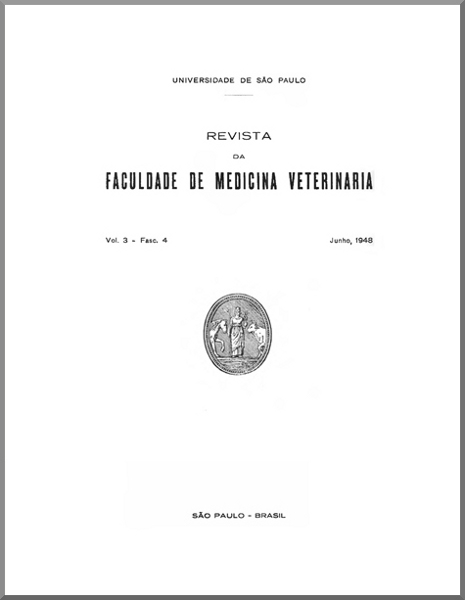Distância do Torus pyloricus à Papilla duodeni hepatica em bovinos mestiços de zebu
DOI:
https://doi.org/10.11606/issn.2318-5066.v3i4p223-246Palavras-chave:
O artigo não apresenta palavras-chave.Resumo
Na presente contribuição ao estudo das vias biliares extrahepáticas, em bovinos mestiços de Zebu, procurou-se estabelecer, estatisticamente, a distância que medeia entre o Torus pyloricus e a abertura do Ductus choledochus na Papilla duodeni hepatica. Foram utilizadas 411 peças obtidas no Frigorífico Armour de S. Paulo, Estado de S. Paulo, sendo 312 provenientes de machos, 14 de fêmeas e as restantes 85 pertencentes a animais cujo sexo não pôde ser determinado. A idade dos bovinos fornecedores do material variava entre 28 e 51 meses aproximadamente. Seguindo técnica minuciosamente descrita, mediram-se 411 peças, depois de fixadas em solução formulada a 10%, durante 72 horas, tendo sido, entretanto, separados dêste grupo, ao acaso, 164 duodenos sôbre os quais se efetuaram duas mensurações, antes e após afixação, para cálculo aproximativo da retratilidade. As conclusões são as seguintes:
1) — A Papilla duodeni hepatica, em 411 peças fixadas, encontrava-se em média a 40.41 ± 0.31 cm do Torus pyloricus, sendo a amplitude de distribuição de 33.12 cm, limitada pelos valores extremos 25.78 e 58.90 cm, e o coeficiente de variabilidade igual a 15.59%;
2) — No grupo de 164 peças medidas antes da fixação obteve-se para a mesma distância a média 45.02 ± 0.49 cm, estando as observações distribuídas entre os dados extremos 33.10 (2 casos) e 67.20 cm, isto é, numa amplitude de variação de 34.10 cm; o coeficiente de variabilidade foi encontrado igual a 13.85%;
3) — Os valores assinalados para êste grupo de 164 peças depois da fixação foram, para a média e respectivo êrro 40.63 ± 0.48cm, para amplitude de variação 29.90 cm e para limites máximo e mínimo desta, respectivamente, 29.00 e 58.90 cm; quanto ao coeficiente de variabilidade atingiu a 15.21%;
4) — A aplicação do “t test” na interpretação da diferença de 4.39 cm entre as duas médias estabelecidas no lote de 164 peças, embora destituída de apreciável importância prática, revelou significância do ponto de vista estatístico, sendo atribuível à fixação pelo formol;
5) — A porcentagem de retratilidade calculada, peça a peça, em 164 duodenos permitiu estabelecessemos a média aritmética e desvio padrão dessa retratilidade: 9.82 ± 4.42%; o coeficiente de variabilidade determinado, em têrmos de porcentagem de retração, a partir dêsses valores atingiu a cêrca de 45%, demonstrando-se, assim, não só a impossibilidade de prever qual o valor teórico aproximado ase esperar caso as 411 peças tivessem sido medidas a fresco, como também ser aconselhável a medida das peças anteriormente à fixação, pois, os resultados obtidos no material não submetido à ação do formol representam mais regular- e precisamente a condição anatômica média;
6) — A superposição das curvas de distribuição por frequências às respectivas curvas normais, referentes ao grupo de 411 peças fixadas (Gráfico I) e ao de 164 peças frescas (Gráfico II) facilitaram-nos a comparação entre os valores atuais e os correspondentes teóricos previsíveis, revelando-nos, outrossim, que as diferenças notadas entre os dados experimentais e normais, em quaisquer dos pontos médios de classe, não são significantes devendo ser atribuídas às flutuações de amostras simples. A classe modal do primeiro grupo, a de37-40 cm, engloba 81.5 peças, ou seja, 19.83% do total; no segundo grupo a classe modal de 41-44 cm, reune 41 peças, isto é, 25% do total. As modas relativas a êstes grupos foram, respectivamente, 38.57 e 42.58 cm;
7) — A aplicação do “t test” mostrou haver significação estatística para as diferenças de 15.68 e 9.98.cm existentes entre as médias deduzidas por BAUMANN e SCHMOTZER (60.70 cm) e por MANN, BRIMHALL e FOSTER (55.00 cm), em bovinos de origem européia, e a calculada por nós em peças frescas (45.02 cm);
8) — Depois de analisar as condições de ordem técnica e os fatores de natureza constitucional correlacionados ao sexo, à idade, ao pêso e à raça, explicando sua interferência na interpretação dos resultados, alvitramos que a menor distância média entre Torus pyloricus e Papilla duodeni hepatica, por nós verificada, face aos dados conhecidos e divulgados através os tratados e publicações especiais, relaciona-se, possivelmente, com o menor comprimento do intestino dos bovinos mestiços de Zebu (Bos indicus) comparativamente aos de origem européia (Bos taurus). Esta hipótese não é inteiramente invalidada pelas conclusões do trabalho do BLACK, SEMPLE e LUSH, respeitantes à não significação estatística para a diferença em comprimento de intestino, notada entre mestiços de Zebu e animais das raças Hereford e Shorthorn. De resto, aquêles AA. afirmam que os tractos digestivos dos mestiços são menores e é preciso comprovar, em material numérica - e qualitativamente adequado, se a diferença é simplesmente de capacidade e de pêso; além do mais, há que considerar terem BLACK , SEMPLE e LUSH trabalhado com animais 1/2 sangue Zebu, enquanto operámos com animais talvez mais de 7/8 ou 15/16 de Zebu.


